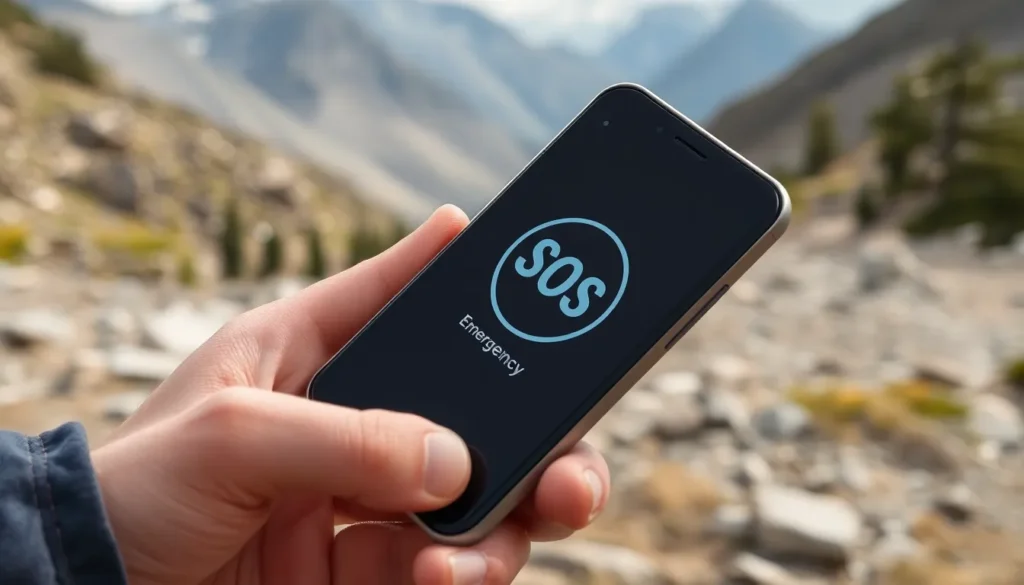Ever noticed that SOS icon flashing on your phone and wondered if it’s a secret message from aliens? Fear not, it’s not a cosmic distress signal. SOS stands for “Save Our Souls,” a universal call for help that’s become a lifeline in the digital age.
In a world where your smartphone is practically an extension of your arm, understanding what SOS means can be crucial. Whether you’re hiking in the wilderness or just trying to figure out why your phone’s acting like a drama queen, knowing how to use this feature could save the day. So let’s dive into the world of SOS and discover how this simple three-letter acronym packs a powerful punch when it comes to safety and communication.
Table of Contents
ToggleUnderstanding SOS
SOS serves as a vital safety feature on smartphones. It enables users to send emergency alerts quickly. Activating SOS varies by device, typically found in the phone’s settings. Many smartphones allow users to call emergency services and share location data simultaneously. This feature proves especially helpful in isolated or dangerous situations.
The SOS function functions differently across operating systems. In iOS, pressing the side button five times quickly initiates the alert. Android devices commonly use the volume buttons in a similar manner. Users should familiarize themselves with their specific device’s actions.
Smartphone manufacturers often include customization options. Some allow users to set emergency contacts, simplifying the process of reaching out for assistance. Distinct sounds or notifications may also signal when the SOS feature is active.
Understanding SOS empowers users to take control in emergencies. Many people find comfort in knowing they can summon help with minimal effort. Regularly reviewing and updating emergency settings enhances preparedness.
The SOS icon doesn’t just symbolize a need for help; it embodies the capability for immediate action. Maintaining awareness of emergency features fosters confidence in navigating various situations.
The Meaning of SOS

The SOS signal represents a universal call for help. It signifies “Save Our Souls” or “Save Our Ship,” highlighting its importance in emergencies and critical situations.
Origin and History
Originating in the early 20th century, SOS became synonymous with distress signals in maritime contexts. In 1905, the International Radiotelegraphic Convention designated it as the standard distress signal. Its simple, recognizable pattern of three short signals, three long signals, and three short signals gave rise to its ease of use. The choice of SOS wasn’t random; its Morse code representation, “··· — ···,” made it easy to transmit via various communication methods. Over time, the signal spread beyond maritime use, integrating into radio communication, and eventually appearing on modern digital devices.
Modern Usage
Modern smartphones incorporate the SOS feature for quick emergency communication. This capability allows users to send location data and alert emergency services rapidly. On iPhones, pressing the side button five times activates the SOS alert. Android devices typically use volume buttons or specific gestures to initiate the same response. Enhanced features enable customization, such as setting emergency contacts who receive alerts. The SOS feature’s integration in smartphones emphasizes its ongoing relevance, providing essential support for personal safety in everyday situations. In regions and situations where connectivity may be limited, this feature can prove crucial.
SOS Features on Your Phone
SOS features on smartphones provide vital assistance during emergencies. Users can quickly send alerts to emergency services and contacts, ensuring timely support in critical situations.
How to Activate SOS
Activating SOS varies by device. On iOS, pressing the side button five times rapidly triggers the emergency call. Alternatively, Android users can usually press the volume buttons multiple times. Some devices also offer an option to activate SOS through the settings menu for easier access. Checking device-specific instructions ensures effective use of the feature in urgent times.
Different Platforms and Devices
Different platforms approach SOS features uniquely. iPhones run iOS 13 or later, enabling users to share their location and alert emergency contacts simultaneously. Android devices, depending on the manufacturer, often have customizable settings for emergency alerts and contacts. Samsung offers a distinct feature that allows users to send SOS messages with location details. Each platform’s approach highlights the importance of familiarizing oneself with specific functions for timely and effective assistance.
Implications of Using SOS
Understanding the implications of using the SOS feature on smartphones plays a crucial role in ensuring personal safety. This feature provides essential support in emergencies, allowing users to communicate swiftly.
Emergency Situations
In emergency situations, SOS acts as a lifeline. Users can quickly alert local authorities by sending distress signals. For instance, when hiking in remote areas, travelers benefit from immediate help options. Also, during medical emergencies, calling for assistance becomes seamless with this feature. Sharing location details increases the chances of prompt rescue, making SOS invaluable in various scenarios. Moreover, advanced smartphones offer shortcuts for quicker access to SOS functionalities, underscoring their importance.
Privacy and Security Concerns
Privacy and security concerns surface with the use of SOS features. Users may worry about sharing location data without consent. However, customization settings often allow individuals to control whom to notify during emergencies. This functionality ensures friends, family or emergency contacts receive critical alerts while protecting sensitive information. In addition, understanding how usage of SOS could influence personal data helps users navigate risks effectively. It’s essential to review device settings, ensuring they strike a balance between safety and privacy.
Understanding the SOS feature on smartphones is essential for personal safety. This tool not only allows users to send emergency alerts but also shares location data, making it invaluable in critical situations. With varying activation methods across devices it’s crucial for users to familiarize themselves with their specific settings.
The SOS icon serves as a reminder of the importance of being prepared and informed. By customizing emergency contacts and settings users can enhance their safety and ensure quick communication when it matters most. Embracing this feature empowers individuals to navigate emergencies with confidence and clarity.





